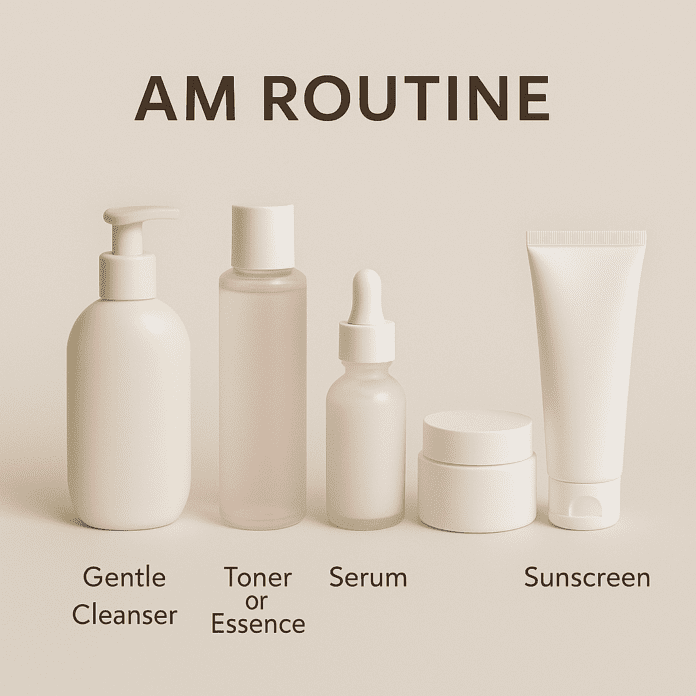You’ve invested in cleansers, serums, moisturizers, and maybe even an essence or two. Your bathroom shelf is a treasure trove of potent ingredients promising glowing, healthy skin. Yet, a nagging question remains: Am I even using these correctly?
If you’ve ever wondered whether your vitamin C serum goes on before or after your hyaluronic acid, or if sunscreen is truly the last step, you’re not alone. The sheer volume of available products has made skincare layering one of the most confusing topics in beauty.
The truth is, the order in which you apply your products is critically important. Using them incorrectly can, at best, render expensive products ineffective and, at worst, lead to irritation and breakouts.
This is your definitive guide to understanding what order to apply skincare for both AM vs. PM routines. We will break down each step, explain the science behind the sequence, and provide a clear, actionable blueprint you can follow starting today. Get ready to unlock the full potential of your skincare products.
Table of Contents
- The Golden Rule of Skincare Layering: Thinnest to Thickest
- The Ultimate Morning (AM) Routine: Your “Protect & Prevent” Mission
- The Ultimate Evening (PM) Routine: Your “Treat & Repair” Mission
- Quick Reference: Your AM vs. PM Skincare Order Cheatsheet
- Common Skincare Layering Mistakes to Avoid
- Frequently Asked Questions (FAQ)
1. The Golden Rule of Skincare Layering: Thinnest to Thickest
If you remember only one thing from this article, let it be this: Apply your skincare products in order of consistency, from the thinnest to the thickest.
Think of it like this: you can’t get a glass of water through a brick wall. Similarly, a thin, watery serum cannot penetrate the rich, occlusive barrier of a thick cream or oil. For products to be absorbed effectively, they need a clear path to your skin.
- Thinner, Water-Based Products First: These include toners, essences, and water-based serums. Their small molecules are designed to absorb deeply into the skin to deliver active ingredients and hydration.
- Thicker, Oil-Based Products Last: These include heavy creams, moisturizers, and face oils. Their larger molecules work on the surface of the skin to lock in moisture and the benefits of the products applied beforehand.
By following this simple rule, you ensure each product can perform its job without being blocked by a heavier one.
2. The Ultimate Morning (AM) Routine: Your “Protect & Prevent” Mission
Your morning skincare routine has one primary goal: to protect your skin from the environmental aggressors it will face throughout the day, namely UV radiation, pollution, and free radicals. The steps are designed to cleanse, hydrate, and create a powerful defensive shield.
Step 1: Cleanser
Start by washing your face with a gentle, hydrating cleanser. While you sleep, your skin can accumulate sweat, oil, and bacteria from your pillowcase. A light cleanse removes this debris without stripping your skin’s natural moisture barrier, which is crucial for its protective function during the day.
- Product Suggestions:
- For All Skin Types: CeraVe Hydrating Facial Cleanser
- For Oily Skin: La Roche-Posay Toleriane Purifying Foaming Cleanser
Step 2: Toner / Essence (Optional)
Modern toners are not the harsh, alcohol-based astringents of the past. Today, they serve to balance the skin’s pH and provide a first layer of hydration. An essence is similar, often with a slightly more viscous texture, designed to deeply hydrate and prep the skin for serums. Swipe a toner on with a cotton pad or press an essence in with your palms onto damp skin.
Step 3: Antioxidant Serum (The MVP)
This is arguably the most important treatment step of your morning routine. An antioxidant serum, most commonly featuring Vitamin C, is a powerhouse that neutralizes free radicals from UV exposure and pollution. It helps prevent cellular damage, brightens the complexion, and can even boost the effectiveness of your sunscreen.
- Product Suggestions:
- Gold Standard: SkinCeuticals C E Ferulic
- Budget-Friendly: Maelove The Glow Maker
- Sensitive Skin: Mad Hippie Vitamin C Serum
Step 4: Eye Cream
The skin around your eyes is the thinnest and most delicate on your face, making it prone to showing signs of aging and fatigue first. A dedicated eye cream is formulated to be gentle yet effective for this area, targeting concerns like dark circles, puffiness, and fine lines. Gently tap it on with your ring finger.
Step 5: Moisturizer
No matter your skin type, moisturizer is essential. It hydrates the skin, locks in the serums you’ve applied, and reinforces your skin’s natural barrier. For daytime, choose a formula that is appropriate for your skin type and wears well under makeup.
- For Oily Skin: A lightweight gel-cream.
- For Dry Skin: A more substantial lotion or cream.
Step 6: Sunscreen (The Absolute Non-Negotiable)
This is the final and most critical step of every single morning routine, 365 days a year, rain or shine. Sunscreen protects your skin from UVA (aging) and UVB (burning) rays, which are the primary cause of premature aging, hyperpigmentation, and skin cancer. It should always be applied as the very last step before makeup, as it is meant to form a protective film on the surface of your skin.
Expert Insight: Always apply at least SPF 30, and use about a nickel-sized dollop for your face, or the “two-finger” rule (squeezing a line of sunscreen on your index and middle fingers) to ensure you’re applying enough.
- Product Suggestions:
- Invisible Finish: Supergoop! Unseen Sunscreen SPF 40
- Korean Beauty Favorite: Beauty of Joseon Relief Sun : Rice + Probiotics (SPF50+ PA++++)
3. The Ultimate Evening (PM) Routine: Your “Treat & Repair” Mission
Your skin’s natural repair processes kick into high gear while you sleep. The goal of your nighttime routine is to support this regeneration by cleansing away the day’s grime and delivering powerful, targeted treatment ingredients.
Step 1: The Double Cleanse
A single cleanse is often not enough to remove the layers of sunscreen, makeup, oil, and environmental pollutants that have accumulated on your skin all day.
- First Cleanse (Oil or Balm): Start with an oil-based cleanser or a cleansing balm. Oil dissolves oil, so this step effectively melts away makeup and sunscreen without stripping the skin. Massage it onto dry skin, then add a little water to emulsify it before rinsing.
- Second Cleanse (Water-Based): Follow up with your regular gel, milk, or cream cleanser. This step cleanses your actual skin, removing any lingering residue and ensuring your face is perfectly prepped for the treatments to follow.
- Product Suggestions (First Cleanse):
Step 2: Exfoliating Treatment (2-3 times a week)
On nights you exfoliate, this is the time to do it. After cleansing, use a chemical exfoliant with AHAs (like glycolic or lactic acid) to address surface texture and pigmentation, or a BHA (salicylic acid) to get deep into pores. This removes dead skin cells, allowing your other products to penetrate more effectively.
Important Note: Do not use a strong exfoliant on the same night you use retinol, especially when you are just starting out, as this can lead to significant irritation.
Step 3: Toner / Essence
Just as in the morning, a hydrating toner or essence can be used here to add moisture back into the skin after cleansing and exfoliating, prepping it for your treatment serums.
Step 4: Treatment Serums (The Powerhouses)
Nighttime is when you bring out the heavy hitters. This is the time for ingredients that promote cell turnover, repair damage, and build collagen. The most famous of these is retinol (or other retinoids).
- How to Layer Serums: If using multiple serums (e.g., a hydrating one and a treatment one), apply the thinnest one first. For example, apply a hyaluronic acid serum, wait a minute, and then apply a niacinamide serum.
- The Retinol Rule: Retinoids are potent. To minimize irritation, many dermatologists recommend applying them to completely dry skin. You can either apply your retinol serum now, or use the “sandwich method”: apply a thin layer of moisturizer, then your retinol, and then another layer of moisturizer.
Step 5: Eye Cream
Apply your nighttime eye cream. You can use a richer, more reparative formula in the evening than you would during the day.
Step 6: Moisturizer / Night Cream
A night cream is generally thicker and richer than a day cream. It’s formulated with a higher concentration of emollients and hydrating ingredients to support your skin’s barrier and repair processes overnight, sealing in all your treatment serums.
Step 7: Face Oil (Optional, for Dry Skin)
If you have dry or dehydrated skin, a face oil can be a luxurious final step. Oils are occlusive, meaning they create a seal on the surface of the skin that prevents water loss while you sleep. Gently press a few drops into your skin after your moisturizer.
4. Quick Reference: Your AM vs. PM Skincare Order Cheatsheet
| Morning (AM) Routine – PROTECT | Evening (PM) Routine – REPAIR |
| 1. Gentle Cleanser | 1. Oil/Balm Cleanser (First Cleanse) |
| 2. Toner / Essence | 2. Water-Based Cleanser (Second Cleanse) |
| 3. Antioxidant Serum (e.g., Vitamin C) | 3. Exfoliant (2-3x a week, not with Retinol) |
| 4. Eye Cream | 4. Toner / Essence |
| 5. Moisturizer | 5. Treatment Serums (e.g., Retinol, Peptides) |
| 6. Sunscreen (SPF 30+) | 6. Eye Cream |
| 7. Moisturizer / Night Cream | |
| 8. Face Oil (Optional) |
Export to Sheets
5. Common Skincare Layering Mistakes to Avoid
- Applying to Wet Skin (Sometimes): While hyaluronic acid loves damp skin, potent actives like retinol and vitamin C should be applied to dry skin to avoid irritation and ensure stability.
- Not Waiting Between Layers: Give each product about 30-60 seconds to absorb before applying the next. This prevents products from pilling (balling up) and ensures each one has time to start working.
- Overloading on Actives: Don’t use a Vitamin C serum, an AHA/BHA exfoliant, and a Retinoid all in one routine. This is a recipe for a compromised skin barrier. Use antioxidants in the AM and alternate between exfoliants and retinoids in the PM.
- Applying Oil Before Cream: Remember, oils are sealants. If you apply an oil before your water-based moisturizer, the moisturizer won’t be able to penetrate.
6. Frequently Asked Questions (FAQ)
Q1: How long should I really wait between skincare steps? A good rule of thumb is to wait until a product is no longer tacky to the touch, usually 30-60 seconds. For active ingredients like retinoids or prescription treatments, waiting 5-10 minutes for your skin to dry completely is often recommended.
Q2: Do I really need a different routine for AM and PM? Yes. Think of it as two different jobs. Your AM routine is your skin’s “bodyguard,” protecting it from the day. Your PM routine is its “repair crew,” fixing damage and regenerating cells. Using a retinoid during the day is ineffective as it’s broken down by sunlight, and skipping sunscreen in the AM leaves your skin vulnerable.
Q3: I use a prescription acne treatment. Where does that fit in? Always consult your dermatologist, but the general rule is to apply prescription topicals to clean, dry skin right after cleansing. Then, you can continue with the rest of your routine. For more information on specific skin conditions, refer to authoritative sources like the American Academy of Dermatology (AAD).
Conclusion
Mastering the order of your skincare application is the single most effective way to ensure you’re getting the most out of your products. By embracing the “thinnest to thickest” philosophy and understanding the distinct goals of your morning and evening routines—Protect in the AM, Repair in the PM—you transform a confusing chore into a powerful, effective ritual.
While it may seem like a lot of steps, this sequence will quickly become second nature. The glowing, healthy, and resilient skin you’ll achieve will be well worth the effort.







